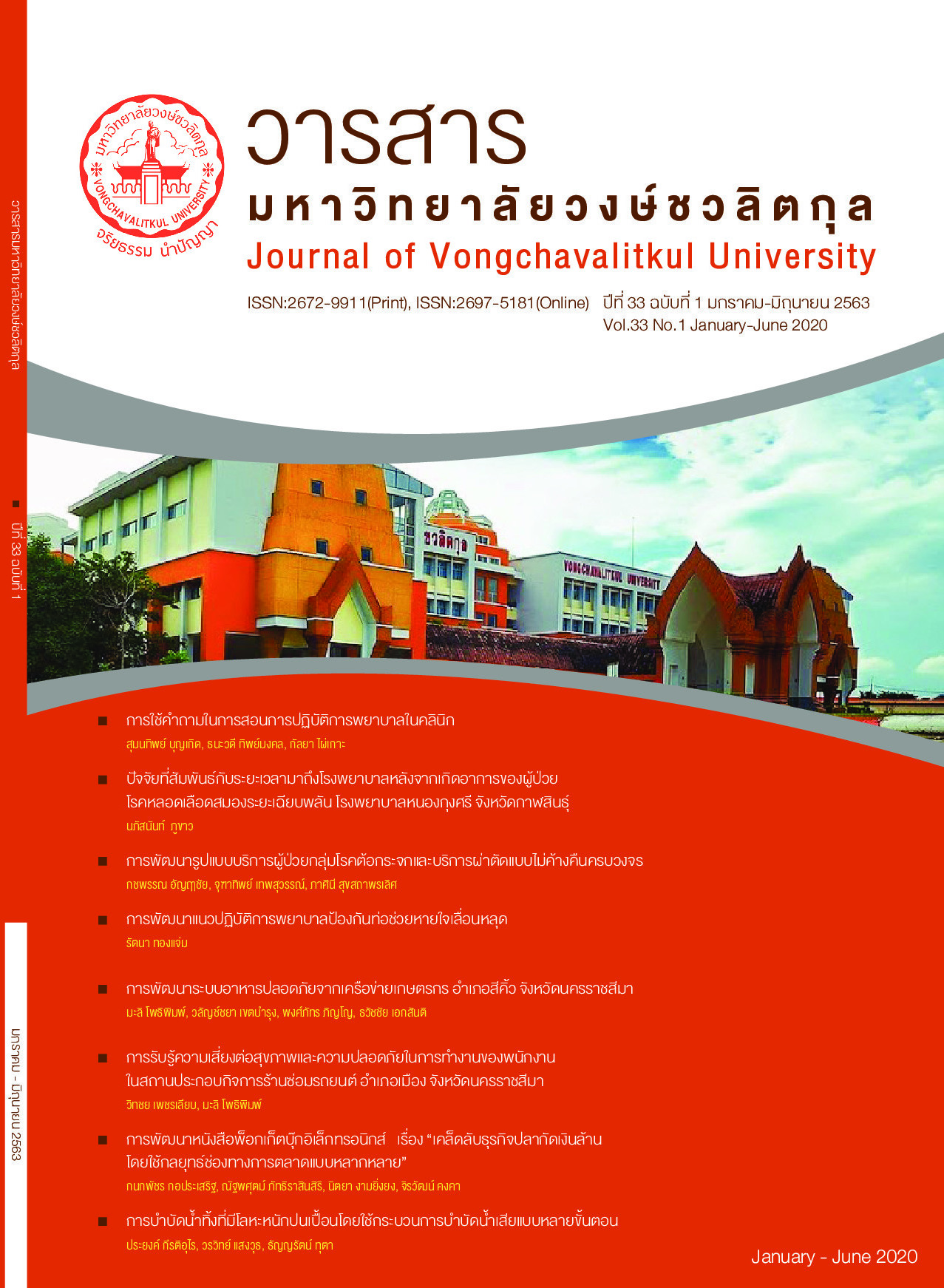Treatment of wastewater contaminated with heavy metals using the multi-stage wastewater treatment process
Main Article Content
Abstract
The objective of this research was the development of appropriate methods to treat wastewater from environmental laboratory of the Vongchavalitkul University.
This research used the multi-stage process for wastewater treatment. Which they were the 4 series of consecutive wastewater treatment systems. The series 1 of wastewater treatment system were acid-alkaline conditioning tank with NaOH until pH as 7-8.8 and sedimentation tank. The series 2 of wastewater treatment were the system of trickling filters with the 3/4 inches of rocks and coarse sand. The uniformity coefficient of coarse sand was 2.53. The total volumes of trickling filters were 0.3 m3. The series 3 of wastewater treatment system were the constructed wetland with the cattail that the areas of them were 0.88 m2. The final systems of wastewater treatment were the biological pond that the volume of them were 0.52 m3. Tilapia and catfish were used as the indicators of water quality. The hydraulic retention time was 12 days. This research analyzed 9 parameters that were COD, BOD, TS, TDS, SS, Mn, Hg, Ag and Cr that they were evaluated the efficiency of the multi-stage process. Wastewater was imported into the batch treatment system. The wastewater would flow continuously until the flows out of the system at the last pond.
The results showed that the efficiencies of wastewater treatment varied directly with the hydraulic retention times. The removal efficiencies of COD, BOD, TS, TDS, SS, Mn, Hg, Ag and Cr were 81.25%, 90.09%, 97.94%, 97.36%, 100%, 100%, 99.91%, 100% and 100%, respectively. The all parameters after treatment had properties according to the standard of effluent discharged from industrial plants.
Article Details
References
2. กรมควบคุมมลพิษ. (2555). ระบบบำบัดน้ำเสียแบบบึงประดิษฐ์. [ออนไลน์] สืบค้น 24 มิถุนายน 2561, จาก: https://www.pcd.go.th
3. กรมวิทยาศาสตร์บริการ. (2553). IR2-การดูดซับโลหะหนักโดยวิธีทางชีวภาพ. สำนักหอสมุดและศูนย์สารสนเทศวิทยาศาสตร์และเทคโนโลยี กระทรวงวิทยาศาสตร์และเทคโนโลยี. [ออนไลน์] สืบค้น 20 กุมภาพันธ์ 2563, จาก: https://www.siweb.dss.go.th
4. กรมส่งเสริมคุณภาพสิ่งแวดล้อม. (2542). มลพิษอื่นและของเสียอันตราย. คู่มือกฎหมายสิ่งแวดล้อมสาหรับประชาชน. กระทรวงวิทยาศาสตร์ เทคโนโลยีและสิ่งแวดล้อม
5. กิตติศักดิ์ หนูสุรา, สุชาดา ไชยสวัสดิ์, วราภรณ์ เมธาวิริยะศิลป์, สรเสกข์ กุลมัย และสิทธิชัย ฉันท์เฉลิมพร. (2561). การพัฒนาการบำบัดน้ำเสียภายในห้องปฏิบัติการ : น้ำเสียจากการวิเคราะห์สิ่งแวดล้อม. ศูนย์ปฏิบัติการด้านสิ่งแวดล้อม ความปลอดภัยและสุขภาพ. [ออนไลน์] สืบค้น 24 มิถุนายน 2561, จาก: https://www.kmutt.ac.th/rippc/onsitel.htm
6. จารุรัตน์ วรนิสรากุล (2539). ลักษณะสมบัติน้ำ การเก็บตัวอย่าง และการวิเคราะห์คุณภาพน้ำสำหรับโรงงานอุตสาหกรรม. เอกสารประกอบการบรรยายในการสัมมนา และสนับสนุนการพัฒนาเพื่อสิ่งแวดล้อม เขตราษฎร์บูรณะ เมื่อวันที่ 22-23 สิงหาคม 2539 ณ โรงแรมแอมบาสเดอร์ ชลบุรี
7. ชุตินธร มูลทองน้อย. (2543). การปนเปื้อนและการบำบัดโลหะหนักในน้ำเสียจากห้องปฏิบัติการวิเคราะห์ทางเคมี โดยวิธีการตกตะกอนด้วยสารเคมี. ฐานข้อมูลวิทยานิพนธ์ไทย. [ออนไลน์] สืบค้น 24 มิถุนายน 2561, จาก: http://www.thaithesis.org/detail.php?id=44364
8. ประยงค์ กีรติอุไร. (2555). การประปาและวิศวกรรมสุขาภิบาล. มหาวิทยาลัยวงษ์ชวลิตกุล. นครราชสีมา. 177 หน้า
9. พรสุดา ผานุการณ์ และ กนกพร บุญส่ง. (2005). ผลของความเข้มข้นของโลหะหนักต่อประสิทธิภาพการบำบัดของพื้นที่ชุ่มน้ำเทียมโกงกางใบใหญ่. In 31st Congress on Science and Technology of Thailand, 2005 18-20 October 2005; Suranaree University of Technology. 3 หน้า.
10. มั่นสิน ตัณฑุลเวศน์ และไพพรรณ พรประภา. (2538). การจัดการคุณภาพน้ำ และการบำบัดน้ำเสียในบ่อเลี้ยงปลา และสัตว์น้ำอื่นๆ เล่ม 1 การจัดการคุณภาพน้ำ ภาควิชาวิศวกรรมสิ่งแวดล้อม คณะวิศวกรรมศาสตร์ จุฬาลงกรณ์มหาวิทยาลัย
11. มณีรัตน์ องค์วรรณดี. (2542). การกำจัดโลหะหนักออกจากน้ำเสียโรงงานชุบโลหะ โดยใช้โซเดียมโบโรไฮไดรด์. วิทยานิพนธ์วิศวกรรมศาสตรมหาบัณฑิต วิศวกรรมสิ่งแวดล้อม จุฬาลงกรณ์มหาวิทยาลัย. [ออนไลน์] สืบค้น 20 กุมภาพันธ์ 2563, จาก: http://cuir.car.chula.ac.th/handle/123456789/
11705. ISBN: 9743336419
12. สุชาดา ไชยสวัสดิ์, กิตติศักดิ์ หนูสุรา, วราภรณ์ เมธาวิริยะศิลป์, สรเสกข์ กุลมัย, ชาญชัย จิตติพันธ์พรณี. (2544). การพัฒนาวิธีการบำบัดของเสียจากการวิเคราะห์ COD ภายในห้องปฏิบัติการ. การประชุมวิชาการวิทยาศาสตร์และเทคโนโลยีแห่งประเทศไทย ครั้งที่ 27, 16–18 ตุลาคม 2544, หาดใหญ่, จ.สงขลา, หน้า 667
13. Alluri, HK., et al. (2007). Biosorption: An eco-friendly alternative for heavy metal removal. African Journal of Biotechnology. Vol.6, no.25, p.2924-2931.
14. American Public Health Association.; American Water Works Association.; Water Environment Federation. (2012). Standard methods for the examination of water and wastewater. National government publication: English: 22nd ed. Washington. D.C.
15. Hussein, H., et al. (2004). Biosorption of heavy metals from wastewater using Pseudomanas sp. Electronic Journal of Biotechnology, April, vol.7, no.1, p.38-46.
16. Metcalf and Eddy. Inc. (1991). Wastewater Engineering: Treatment, Disposal and Reuse. International Edition McGraw-Hill. New York.
17. Tayim, HA, and Al-Yazouri, AH. (2005). Industrial wastewater treatment using local natural soil in Abu Dhabi, U.A.E. American Journal of Environmental Sciences, vol. 1, no. 3, p. 190-193.


